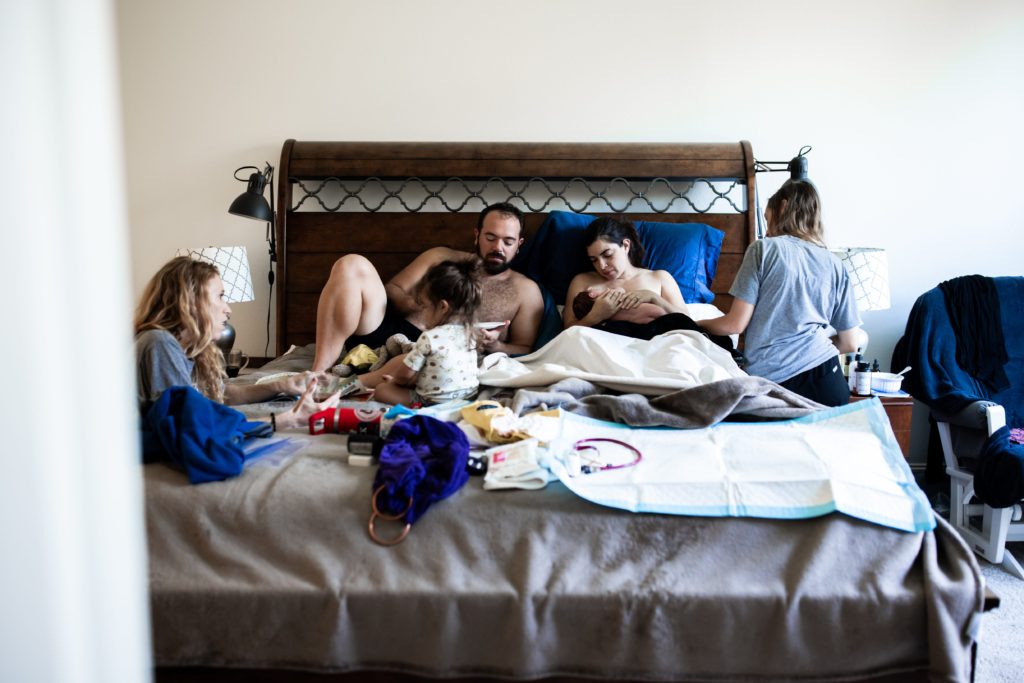“Birth where you’re comfortable” is a great notion, but how much have we really allowed women to explore that idea when the overarching theme of birth in today’s society is that it’s horrible, something to fear, and likely to kill you without the assistance of modern medicine?
Going in with that conception of birth, of COURSE 98% of women will feel most “comfortable” at a hospital. After all, birth is risky, a homebirth is a death sentence for you and your baby, and any choice other than a hospital is irresponsible. Right?
It has only been in the last century that birth went from 100% at home to nearly 100% in a hospital.
There’s not a day that goes by that I don’t read in mom forums “I birthed at the hospital just in case something went wrong so I was right by the OR if needed.” But how often do things actually go wrong that truly need that type of medical intervention?
Did nature really mess up the birth process so astronomically that a third requires surgery to complete? Or have we all been duped into thinking birth is a medical event rather than a natural process that sometimes needs medical intervention?
What do you want out of birth?
Considering the type of birth you want before choosing a location is important. What do you want it to look like, feel like, smell like, taste like?
If you want an unmedicated, undisturbed, physiological birth, home is likely your best location to achieve that.
If you’re seeking a medicated, highly managed birth, the hospital is likely your best location.
As we’ll talk about, you can get remnants of the former in the latter, but it’s not possible to have a truly physiological (undisturbed, guided 100% by the mother) birth in a hospital.
Why not Home?
This past year, homebirth rates reached a 30 year high in the US. Still, less than 2% of births take place outside of the hospital. Surely not all these women that chose to birth at home are irresponsible or unreasonable.
I hear often quoted transfer rates of up to 40% for homebirths, yet what is not mentioned is that those stats include unplanned homebirths, aka mamas who just didn’t leave the house in time to get to the hospital and “transfer” after baby is born even though the hospital was her destination all along.
When considering a planned homebirth, the transfer rate is actually closer to 10% (slightly higher for first time moms) with the most common reason being maternal exhaustion.
Planned homebirths also have fewer interventions (induction, continuous heart rate monitoring, episiotomy, tool-assisted delivery, c-section), shorter labors, fewer tears, fewer maternal deaths from infection, higher birth satisfaction rates, and higher breastfeeding rates.
For me, one of the biggest appeals was climbing into my own bed with my baby after working so hard and cuddling up in the comfort of my own home. Not having to drive anywhere while in labor was also very high on my list of positives for homebirth.
While not every woman is a candidate for a homebirth, more are than many assume. First time mamas, VBAC mamas (there are some midwives that will support a mama at home after multiple c-sections as well), mamas of certain shapes and sizes, and mamas of twins are often thought to be disqualified from homebirth, yet often those are the categories of mamas who see better outcomes planning a homebirth over a hospital birth.
There are also definitely things that may disqualify homebirth – truly high risk pregnancy, distance from hospital, or availability of a birth attendant in your area.
Why not hospital?
For those truly high risk mamas, the hospital definitely is the safest birth location. Often, those births will actually need medical intervention, and it’s wonderful that we have that ability. Between 6 and 8% of pregnancies are considered high-risk.
In the event of an unforeseen emergency, you are right by an operating room, the NICU, and other medical technology that may be able to help you or baby without a transfer of care.
Another hospital advantage (and maybe the biggest reason I hear these days as to why a mama chooses the hospital) is the pain medication available, namely the epidural.
Many mamas go into a hospital birth hoping to have an unmedicated birth or to “see what happens” in labor to decide if they’ll get the epidural or not.
The reality is a hospital is set up for medical intervention. There’s no way around that. Interrupting the natural course of birth is protocol. That’s not to say that doctors and nurses are all out to get you; their routines and jobs literally are to intervene in your birth and its natural process. Policy and protocol rules the day, interruptions of staff coming and going is standard, and separating mama and baby is routine.
The in between: why not birth Center?
A birth center is often seen as the middle ground between home and hospital.
Unfortunately, it’s really neither. It’s not your home, though the homey atmosphere is nice. And it doesn’t come with the medical care found in a hospital.
That being said, many mamas may choose a birth center if their home can’t accommodate a homebirth or they don’t have child care for older siblings.
Truly, there is no difference in care between a freestanding birth center and a homebirth. Midwives have the same equipment available at both locations, so the biggest factor differentiating the two is who does the driving – mama to the birth center or the midwife to mama’s house.
Some hospitals are capitalizing on the desire for a more homey atmosphere and have incorporated birth centers attached to the hospital. Unfortunately, most of these hospital-linked birth centers seem to be little more than an extension of the maternity wing, carrying over the same policies and protocols that a mama desiring a birth center or homebirth is likely hoping to avoid.
The bottom Line
We’re at a time where at least a third and maybe even up to almost half of mamas look back on their childbirth experience as traumatic, often reportedly due to treatment from their provider embedded in a system so far removed from the actual needs of a birthing woman.
At the end of the day, birthing outside the hospital is just as safe (or risky, depending on your perspective) as inside hospital if you’re judging solely based on survival. Mortality rates of both locations are pretty equal. But if we have standards beyond that – birth satisfaction, fewer interventions, breastfeeding success, postpartum mood disorders – home starts to look like a much better option for more women than may realize it.

